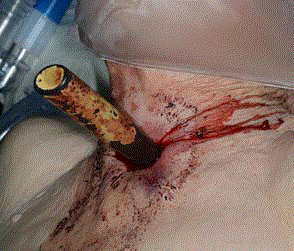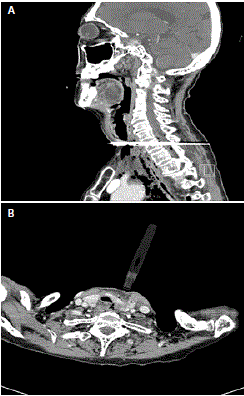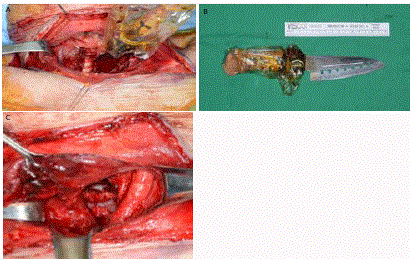Case Report
Stabbing Neck Injury with Complete Spinal Cord Transection and Neurogenic Shock: A Case Report
Keon-Ho Kim, Chang Myeon Song, Yong Bae Ji and Kyung Tae*
Department of Otolaryngology-Head and Neck Surgery, Hanyang University, Korea
*Corresponding author: Kyung Tae, Department of Otolaryngology-Head and Neck Surgery, Hanyang University, Korea
Published:
Cite this article as: Kim K-H, Song CM, Ji YB, Tae K.
Stabbing Neck Injury with Complete
Spinal Cord Transection and
Neurogenic Shock: A Case Report. Clin
Surg. 2018; 3: 2113.
Abstract
Penetrating neck injury is a relatively uncommon type of traumatic injury that has potential for
significant morbidity and mortality. Therefore, a patient with a penetrating neck injury must be
examined promptly and treated urgently; this is especially important because spinal cord injury
can cause variable motor and sensory deficits with loss of the sympathetic tone, which can lead to
neurogenic shock and death. In this article, we describe a case of stabbing neck injury with complete
spinal cord transection and neurogenic shock, and we review the relevant literature.
Keywords: Penetrating neck injury; Stabbing injury; Spinal cord injury; Neurogenic shock
Introduction
Penetrating neck injury is a relatively uncommon type of traumatic injury that has the potential
for significant morbidity and mortality [1,2]. The neck contains various important structures
such as the major vessels, nerves, trachea, esophagus, and spinal cord. Therefore, a patient with a
penetrating neck injury must be examined and treated promptly [3]. Non-operative management
can be adequate sometimes, but emergency surgical intervention performed in the operation room
by a head and neck surgeon, a thoracic surgeon, and a neurosurgeon is usually required depending
on the extent of the injury.
When a patient with a penetrating neck injury is hemodynamically stable, comprehensive
physical examination and imaging studies must be performed initially. However, if there is active
bleeding, progressive edema, or shock, surgical exploration should be performed as soon as possible.
The major vessels, esophagus, larynx, trachea, and spinal cord must be examined thoroughly; primary
repair, ligation, or decompression should be performed according to the specific indications in each
case [4].
Penetrating neck trauma can be caused by a gunshot (50%), a stabbing (10~20%), or another
cause [5]. Stabbing spinal injury is uncommon. It usually occurs as a result of interpersonal violence.
The most common site of stabbing spinal injury is the thoracic spine, and stabbing injury to the
cervical spine is rare [6]. When the knife blade is retained in the neck, it is typically lodged in the
vertebral body, lamina, or pedicle, making it difficult to remove.
In practice, complete spinal cord injury due to stabbing with a retained knife blade is very rare.
In this article, we describe a case of penetrating neck injury with complete spinal cord transection
and neurogenic shock, and we review the relevant literature.
Case Presentation
An 85-year-old woman was brought to the emergency room by her son due to a penetrating
stab injury on the anterior neck. A kitchen knife was deeply stuck in the midline of the anterior
neck, but there was no active bleeding (Figure 1). The patient was semiconscious, and bradycardia
and hypotension were noted. She had been diagnosed to have dementia and depression a long time
previously. She thrust herself against a knife positioned at the level of the neck for the purpose of
committing suicide, and the knife penetrated her neck. She bowed forward a few more times while
the knife was stuck in her neck so that it would get deeper.
Initial imaging of the neck using Computed Tomography (CT) with contrast enhancement
showed the knife had penetrated the spinal cord completely, and there was a fracture of the T1
vertebral body; injuries to the esophagus and thyroid were also suspected (Figure 2A and 2B).
The emergency operation was performed immediately under general anesthesia. Extracorporeal Membrane Oxygenation (ECMO) circuit was inserted in preparation
for cardiopulmonary bypass, and the stab wound was explored with
extension of the neck wound. It was noted that the knife blade had
penetrated the soft tissues of the neck and was stuck on the vertebra.
The knife had passed between the trachea and left common carotid
artery; therefore, the trachea, common carotid artery, and internal
jugular vein were intact . After a careful removal of
the knife blade (Figure 3B), it was observed there was complete
transection of the spinal cord and a fracture of whole body of the T1
vertebra (Figure 3C). In addition, esophageal lacerations measuring
1.0 cm and 0.5 cm were noted, and they were closed primarily.
The patient was tetraplegic, and her body temperature and
Blood Pressure (BP) fluctuated postoperatively. On the 4th day after
the surgical procedure, severe hypotension (BP, 50/20 mmHg)
and bradycardia (pulse rate, 26) were noted. Cardiopulmonary
resuscitation was performed immediately, and the vital signs were
restored. Conservative treatment was administered under the
impression that the patient was having neurogenic shock. However,
the vital signs remained unstable, and the patient died 17 days after
the surgical procedure.
Figure 1
Figure 2
Figure 2
Sagittal (A) and axial (B) computed tomographic images showed
the retained knife had penetrated the spinal cord completely, and there was
a fracture of the T1 vertebral body.
Discussion
A patient with a penetrating neck injury is often in a lifethreatening
condition [7]. Most patients should undergo an
emergency operation for exploration, and the mortality is variable
depending on the extent and degree of the injury.
Neck injuries can occur in three areas: area I – from the clavicles
to the lower edge of the cricoid cartilage; area II - from the lower edge
of the cricoid cartilage to the angle of the jaw; and area III - from the
angle of the jaw to the skull base [8]. Area II injuries usually require
immediate surgical exploration, whereas area I and III injuries may
require further investigation with angiography, bronchoscopy,
esophagoscopy, and swallowing tests [9,10].
A stabbing neck injury that involves the spinal cord can manifest
with variable symptoms depending on the degree and level of injury
[11]. The spinal cord is very sensitive to injuries and cannot repair
itself if it is damaged. In an incomplete spinal cord injury, some
sensation and movement is possible below the level of the injury. In a
complete spinal cord transection, there is complete loss of motor and
sensory function below the level of the injury; in most cases, both sides
of the body are affected equally [12]. In addition, spinal cord injury
can affect the autonomic nervous system with loss of the sympathetic
tone, which may lead to neurogenic shock. Only the parasympathetic
tone remains in subjects with neurogenic shock. Neurogenic shock
presents with unpredictable cardiovascular dysfunction characterized
by significant hypotension, bradycardia, and hypovolemia; eventually,
it leads to death [13].
The incidence of neurogenic shock is higher in subjects with
cervical spinal cord injury compared with those with thoracic and
lumbar spinal cord injuries [14]. Neurogenic shock is also more likely
to occur in subjects with complete spinal cord injury than in those
with incomplete injury [15]. The current therapeutic management
of spinal cord injury includes early surgical exploration, strict blood
pressure control, and administration of steroids; however, the use
of steroids is debatable. It is also necessary to focus on minimizing
secondary injuries after the primary trauma has occurred [16,17].
When a spinal cord injury is suspected, immobilization of the spine
and decompression of the spinal cord are extremely important
[18]. The retained knife blade must be removed by an experienced
surgeon while the patient is in an operation room to minimize
further injuries and complications [6,19]. Intravenous hydration and administration of dopamine, norepinephrine, or atropine must be
considered in subjects with neurogenic shock to prevent hypotension
or bradycardia. In addition, the patient should be kept warm because
of the risk of hypothermia [20].
Our patient underwent prompt surgical exploration to remove the
retained knife, and appropriate treatment for neurogenic shock was
administered. A large amount of intravenous fluids for hydration and
norepinephrine were administered for the treatment of hypotension
and bradycardia. However, the autonomic dysfunction was very
severe, and the patient died eventually. In practice, few patients with
complete spinal cord transection achieve partial recovery despite the
immediate management of the neurogenic shock [21].
Figure 3
Figure 3
The operative views. (A) During the exploration of the neck, it was
noted that the knife blade had passed between the trachea and left common
carotid artery without injuring them, and it had stuck on the vertebral body.
(B) The removed knife. (C) After careful removal of the knife blade, it was
noted there was complete transection of the spinal cord and a fracture of the
T1 vertebral body.
Conclusion
Stabbing cervical spinal cord injury with a retained knife blade is very rare. Careful assessment and immediate surgical exploration are necessary, and the retained knife must be removed while the patient is in the operating theatre. In addition, physicians should be aware of the possibility of neurogenic shock in patients with spinal cord injury, and they should manage it appropriately because it is unpredictable and it has variable outcomes.
References
- Nowicki JL, Stew B, Ooi E. Penetrating neck injuries: a guide to evaluation and management. Ann R Coll Surg Engl. 2018;100(1):6-11.
- Hua R, Shi J, Wang X, Yang J, Zheng P, Cheng H, et al. Analysis of the causes and types of traumatic spinal cord injury based on 561 cases in China from 2001 to 2010. Spinal Cord. 2013;51(3):218-21.
- Fares YH, Fares JY, Gebeily SE, Khazim RM. Spinal cord injuries due to close combat weapons. Neurosciences (Riyadh). 2013;18(4):375-7.
- Shiroff AM, Gale SC, Martin ND, Marchalik D, Petrov D, Ahmed HM, et al. Penetrating neck trauma: a review of management strategies and discussion of the 'No Zone' approach. Am Surg. 2013;79(1):23-9.
- Ball CG. Penetrating nontorso trauma: the head and the neck. Can J Surg. 2015;58(4):284-5.
- Enicker B, Gonya S, Hardcastle TC. Spinal stab injury with retained knife blades: 51 Consecutive patients managed at a regional referral unit. Injury. 2015;46(9):1726-33.
- Lochowski M, Kaczmarski J, Brzezinski D, Cieslik-Wolski B, Kozak J. Penetrating neck traumas. Kardiochir Torakochirurgia Pol. 2014;11(1):30-3.
- Fernandez EM, Moreno-Luna R, Navas FL, Porras ML, Gimenez C, Gomez SS. Transverse cervicothoracic stabbing: multidisciplinary management of a surgical emergency. Turk Arch Otorhinolaryngol. 2017;55(3):144-7.
- Roepke C, Benjamin E, Jhun P, Herbert M. Penetrating neck injury: what's in and what's out? Ann Emerg Med. 2016;67(5):578-80.
- Salzman S, Varella E, Doherty J, Fishman D, Merlotti G. Retained cervical stabbing implement with associated ischemic spinal cord injury. J Trauma. 2004;57(5):1140.
- Fatehi D, Dayani MA, Rostamzadeh A. Role of CT scan in theranostic and management of traumatic spinal cord injury. Saudi J Biol Sci. 2018;25(4):739-46.
- TerWengel PV, Feller RE, Stadhouder A, Verbaan D, Oner FC, Goslings JC, et al. Timing of surgery in traumatic spinal cord injury: a national, multidisciplinary survey. Eur Spine J. 2018;27(8):1831-8.
- Hagen EM. Acute complications of spinal cord injuries. World J Orthop. 2015;6(1):17-23.
- Ruiz IA, Squair JW, Phillips AA, Lukac CD, Huang D, Oxciano P, et al. Incidence and natural progression of neurogenic shock after traumatic spinal cord injury. J Neurotrauma. 2018;35(3):461-6.
- Taylor MP, Wrenn P, O'Donnell AD. Presentation of neurogenic shock within the emergency department. Emerg Med J. 2017;34(3):157-62.
- Donovan J, Kirshblum S. Clinical trials in traumatic spinal cord injury. Neurotherapeutics. 2018.
- Ropper AE, Neal MT, Theodore N. Acute management of traumatic cervical spinal cord injury. Pract Neurol. 2015;15(4):266-72.
- Rabinstein AA. Traumatic Spinal Cord Injury. Continuum (Minneap Minn). 2018;24(2, Spinal Cord Disorders):551-66.
- Villarreal-Garcia FI, Reyes-Fernandez PM, Martinez-Gutierrez OA, Pena-Martinez VM, Morales-Avalos R. Direct withdrawal of a knife in the lumbar spinal canal in a patient without neurological deficit: case report and review of the literature. Spinal Cord Ser Cases. 2018;4:48.
- Fox AD. Spinal shock. Assessment and treatment of spinal cord injuries and neurogenic shock. JEMS. 2014;39(11):64-7.
- Saeidiborojeni HR, Moradinazar M, Saeidiborojeni S, Ahmadi A. A survey on spinal cord injuries resulting from stabbings: a case series study of 12 years' experience. J Inj Violence Res. 2013;5(1):70-4.



